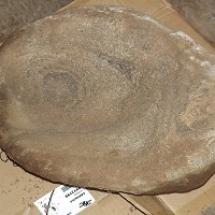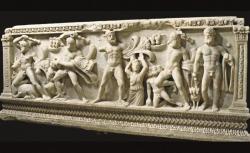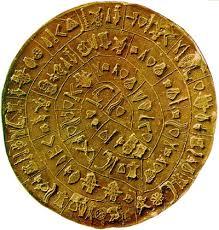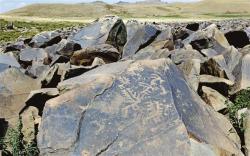INSTITUT SUPERIEUR D'ANTHROPOLOGIE
INSTITUTE OF ANTHROPOLOGY
ONLINE COURSES / COURS A DISTANCE
WINTER TERM : JANUARY 2015
REGISTER NOW
ROYAUME UNI –  Point Braighe - Archaeologists have discovered Bronze Age pottery during a dig at a site on the Isle of Lewis. More than 100 fragments of pottery thought to date from around 2000 BC were found during recent work at Point Braighe, just outside Stornoway. A saddle quern, normally used for grinding wheat, was the first discovery, with many more artefacts soon unearthed. Lead archaeologist Alastair Rees believes the large quantities of pottery as well as evidence of burning, quartz and stone tools and a lack of domestic waste such as animal bone or shellfish remains might suggest that the area served as a type of processing site, although it is not clear what was being produced. What is clear, however, is that the site is probably part of a much more extensive settlement, he said. "It wasn't so much what we were finding but what we weren't finding. We have found a lot of pottery and evidence of repeated peat fires but we have not been finding much in the way of domestic refuse - bone, shell and waste material from domestic occupation," he said. "We initially thought we were looking at a standard round building, but the more we excavated and the more we cleaned up, the more we discovered it was a spread of material - more like a processing area rather than an actual structure. "There was no residue on the quern, so we aren't sure what they were grinding - it might be they were grinding something else. The type of stone was quite fragile and my feeling is that if they were grinding wheat on it then it wouldn't be very nice to eat bread with the flour made from it because it would be full of fragments. It would be like eating a sandwich with a teaspoon full of sand in it. "It could be the quern was used in processing something other than wheat which would tie in with the other findings we have made." The pieces, found over the last three to four weeks, were also initially thought to date from the Iron Age but, as more pottery was discovered, specialists found them to be much older. The excavation is continuing and archaeologists hope more items can be found.
Point Braighe - Archaeologists have discovered Bronze Age pottery during a dig at a site on the Isle of Lewis. More than 100 fragments of pottery thought to date from around 2000 BC were found during recent work at Point Braighe, just outside Stornoway. A saddle quern, normally used for grinding wheat, was the first discovery, with many more artefacts soon unearthed. Lead archaeologist Alastair Rees believes the large quantities of pottery as well as evidence of burning, quartz and stone tools and a lack of domestic waste such as animal bone or shellfish remains might suggest that the area served as a type of processing site, although it is not clear what was being produced. What is clear, however, is that the site is probably part of a much more extensive settlement, he said. "It wasn't so much what we were finding but what we weren't finding. We have found a lot of pottery and evidence of repeated peat fires but we have not been finding much in the way of domestic refuse - bone, shell and waste material from domestic occupation," he said. "We initially thought we were looking at a standard round building, but the more we excavated and the more we cleaned up, the more we discovered it was a spread of material - more like a processing area rather than an actual structure. "There was no residue on the quern, so we aren't sure what they were grinding - it might be they were grinding something else. The type of stone was quite fragile and my feeling is that if they were grinding wheat on it then it wouldn't be very nice to eat bread with the flour made from it because it would be full of fragments. It would be like eating a sandwich with a teaspoon full of sand in it. "It could be the quern was used in processing something other than wheat which would tie in with the other findings we have made." The pieces, found over the last three to four weeks, were also initially thought to date from the Iron Age but, as more pottery was discovered, specialists found them to be much older. The excavation is continuing and archaeologists hope more items can be found.
http://www.milngavieherald.co.uk/news/scottish-headlines/bronze-age-pottery-unearthed-1-3582068
CHINE - Taohe - A bear skeleton unearthed in central China's Henan Province may reveal that Chinese people tamed bears at least 2,800 years ago, said archaeologists. The skeleton was discovered at a cultural relic site in Taohe Town in Nanyang City by archaeologists from Henan Provincial Institute of Cultural Relics and Archaeology (HPICA). The team was called in to perform a rescue excavation when relics were discovered at the construction site of China' s south-to-north water diversion project. Archaeologists estimate that the relic where the beast was buried was a sacrificial pit from the late period of the Western Zhou Dynasty (11th century to 771 B.C.). "We don't know yet when Chinese began to tame bears, but from the discovery of the skeleton we can at least infer that they had the practice during the late Western Zhou Dynasty," said Ma Xiaolin, archaeologist with HPICA. After digging up and analyzing the bones, scientists speculated that the bear was tamed by ancient Chinese to be an offering to ancestors. Judging from the shape of the beast's teeth and skull, it was a black bear, said Hou Yanfeng, another archaeologist with HPICA. It was male, based on the large sagittal crest on its skull, he added. From examining its lower teeth, scientists believe that it died in the early spring when it was five years old. The team also found that the bear's left leg was 29 mm shorter than the right one. "To further investigate the cause of the limp, we had the left leg bone X-rayed and found that the leg had probably suffered from a fracture when the bear was a cub." But the bear's survival and normal development of other bones suggest that the injury did not cause many adverse effects, such as starvation or danger of becoming prey for other animals. However, it was probably captured and raised by humans as a result of the injury when it was a cub and less ferocious, and ended up as a sacrifice buried in the pit, archaeologists said. According to Hou, the sacrificial pit is located at the birthplace of Chu, an ancient Chinese state in today's neighboring provinces of Hubei and Hunan, as well as part of Henan. "Chu people bore the ancestral name of Xiong, or Bear, so it is very likely that bears were tamed and raised for sacrificial use at that time."
http://news.xinhuanet.com/english/china/2014-10/22/c_133735018.htm
TURQUIE –  Perge - A 20-ton sarcophagus, which was seized at the Swiss Customs in 2012, was smuggled from the ancient city of Perge in the southern province of Antalya, according to Turkish officials, who have closely pursued and examined the artifact.The ancient city where the sarcophagus is thought to have been smuggled from, Perge, or modern-day Antalya’s Aksu district, was one of the most important cities in the Hellenistic and Roman periods. Images forming part of the details on the sarcophagus include the depiction of the 12 tasks or labors the ancient Greek hero Heracles had to endure to become an immortal.
Perge - A 20-ton sarcophagus, which was seized at the Swiss Customs in 2012, was smuggled from the ancient city of Perge in the southern province of Antalya, according to Turkish officials, who have closely pursued and examined the artifact.The ancient city where the sarcophagus is thought to have been smuggled from, Perge, or modern-day Antalya’s Aksu district, was one of the most important cities in the Hellenistic and Roman periods. Images forming part of the details on the sarcophagus include the depiction of the 12 tasks or labors the ancient Greek hero Heracles had to endure to become an immortal.
http://www.hurriyetdailynews.com/officials-confirm-heracles-smuggled-from-antalyas-perge.aspx?pageID=238&nID=73274&NewsCatID=375
GRECE –  Phaistos - The decoding of the Phaistos Disk has puzzled specialists for over a century, however new findings describe the disk as “the first Minoan CD-ROM’ featuring a prayer to a mother. Gareth Owens, Erasmus coordinator at the Technological Educational Institute (TEI) of Crete, speaking at the TEI of Western Macedonia on Monday, said the disk is dedicated to a “mother”. “The most stable word and value is ‘mother’, and in particular the mother goddess of the Minoan era,” said Dr. Owens. He says there is one complex of signs found in three parts of one side of the disk spelling I-QE-KU-RJA, with I-QE meaning “great lady of importance” while a key word appears to be AKKA, or “pregnant mother,” according to the researcher. One side is devoted to a pregnant woman and the other to a woman giving birth. The disk was discovered in 1908 at the palace of Phaistos, in the northeastern part of the Aegean Island of Crete.The round clay object, tentatively dated close to 1700 B.C., displays an unknown language on both sides which is carved in a circular fashion, from outside to the centre.
Phaistos - The decoding of the Phaistos Disk has puzzled specialists for over a century, however new findings describe the disk as “the first Minoan CD-ROM’ featuring a prayer to a mother. Gareth Owens, Erasmus coordinator at the Technological Educational Institute (TEI) of Crete, speaking at the TEI of Western Macedonia on Monday, said the disk is dedicated to a “mother”. “The most stable word and value is ‘mother’, and in particular the mother goddess of the Minoan era,” said Dr. Owens. He says there is one complex of signs found in three parts of one side of the disk spelling I-QE-KU-RJA, with I-QE meaning “great lady of importance” while a key word appears to be AKKA, or “pregnant mother,” according to the researcher. One side is devoted to a pregnant woman and the other to a woman giving birth. The disk was discovered in 1908 at the palace of Phaistos, in the northeastern part of the Aegean Island of Crete.The round clay object, tentatively dated close to 1700 B.C., displays an unknown language on both sides which is carved in a circular fashion, from outside to the centre.
http://www.teicrete.gr/daidalika/pages/page.php?page=home
VIDEO = http://www.youtube.com/watch?v=6Chcplx3tZ8
USA –  Everglades – Archaeologists are poking through the muck under a boardwalk in Everglades National Park, looking for evidence of a prehistoric culture in an especially challenging search environment. Work began [along] a 0.8-mile trail around a shallow pond amid sawgrass. National Park Service archaeologists this week are sampling sediment down about 10 feet to the bedrock every 5 meters along the boardwalk, sucking up mud and water with an aluminum tube and then dumping the contents over a screen. When the pond was dredged in 1968 after a record drought, a park ranger noticed hundreds of artifacts atop a debris pile. The items were collected and the ranger's notes were catalogued, but the site never was excavated.
Everglades – Archaeologists are poking through the muck under a boardwalk in Everglades National Park, looking for evidence of a prehistoric culture in an especially challenging search environment. Work began [along] a 0.8-mile trail around a shallow pond amid sawgrass. National Park Service archaeologists this week are sampling sediment down about 10 feet to the bedrock every 5 meters along the boardwalk, sucking up mud and water with an aluminum tube and then dumping the contents over a screen. When the pond was dredged in 1968 after a record drought, a park ranger noticed hundreds of artifacts atop a debris pile. The items were collected and the ranger's notes were catalogued, but the site never was excavated.
http://science.newsfactor.com/story.xhtml?story_id=11200B49LQ7K
TURQUIE –  Hakkari- Academics have succeeded in returning to rock paintings dating back 10 millennia for the first time in 54 years after an end to hostilities in the eastern province of Hakkari made it possible to visit the alpine meadow where the art is located. “This place was discovered in 1960 but archaeologists have not come here since then,” said Istanbul University Van Region History and Archaeology Center Director Erkan Konyar. “After 50 years, an archaeology team visited the area this year for the first time. We are examining the rock paintings. They are very important in terms of the prehistory of the region. They are the earliest examples of rock paintings. They depict mountain goats, wild deer, snakes and humans. The paintings were shaped according to the conditions and needs of the era,” Konyar said. “Rock paintings indicate that there were settlements here. They are very simple rock paintings made by migrant groups. Chronological examination show that these paintings were artistic creations of people who lived here 10,000 years ago,” the academic said. The region is home to hundreds of rock paintings, some of which are already under protection, he said, while adding that necessary measures should be taken to protect the rest of the region as well. The rock paintings have been photographed and documented, he said, noting that work would continue in the area.
Hakkari- Academics have succeeded in returning to rock paintings dating back 10 millennia for the first time in 54 years after an end to hostilities in the eastern province of Hakkari made it possible to visit the alpine meadow where the art is located. “This place was discovered in 1960 but archaeologists have not come here since then,” said Istanbul University Van Region History and Archaeology Center Director Erkan Konyar. “After 50 years, an archaeology team visited the area this year for the first time. We are examining the rock paintings. They are very important in terms of the prehistory of the region. They are the earliest examples of rock paintings. They depict mountain goats, wild deer, snakes and humans. The paintings were shaped according to the conditions and needs of the era,” Konyar said. “Rock paintings indicate that there were settlements here. They are very simple rock paintings made by migrant groups. Chronological examination show that these paintings were artistic creations of people who lived here 10,000 years ago,” the academic said. The region is home to hundreds of rock paintings, some of which are already under protection, he said, while adding that necessary measures should be taken to protect the rest of the region as well. The rock paintings have been photographed and documented, he said, noting that work would continue in the area.
http://www.hurriyetdailynews.com/kurdish-peace-bid-allows-for-rediscovery-of-prehistorical-paintings-in-hakkari.aspx?pageID=238&nid=73321&NewsCatID=375